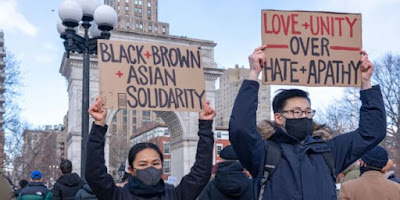In my post twelve reasons i loved the pacific northwest labor history association conference, I listed:
The keynote: "Reckoning with the Past to Move Forward". The keynote speaker was Moon-Ho Jung, a historian at the University of Washington. His speech was riveting, and set the radical tone for the day.
A stranger in a strange land
Jung led the audience through the path that formed his own worldview, and the lens through which he views history. He talked first about growing up as an Asian-American in the Detroit area in the 1970s and 1980s, and his family's discourse around the US and immigration.
My family never sat around and talked about history. But there were lots of historical tidbits that got mentioned over and over. I remember my family talking about how brutal Japanese colonialism in Korea had been.
There was one particular story of Japanese colonial officials ripping the fingernails out of Korean Christians that was told often and in graphic detail. I knew very little about the history of Japanese colonialism, but I was taught from an early age that it had been sadistic and inhumane. To this day, whenever Japanese colonialism is mentioned, I think about fingernails.
The United States, on the other hand, received a far better and lighter treatment in our household. It was a Christian country, the land of freedom. It was the United States that had supposedly liberated Korea from Japanese colonialism.
And that image co-existed somehow with our family's daily encounters with white supremacy in the United States. We encountered a lot of overt racism in Michigan in the 1970s and 1980s.
Growing up in a Reagan Democrat, white working-class neighborhood with the name "Moon-Ho Jung" wasn't exactly easy.
Being called a "chink" or a "Jap" was almost a daily occurrence. One day in elementary school, it got so bad that I came home crying. You know what my mom's advice was: "Tell them you're Korean." Thanks, mom.
Although I blend in better than most people who identify as Asian American or Asian Canadian, I've encountered plenty of anti-Semitism. From a very early age, I was aware that in the scheme of America, Jews are not quite white. Like Jung, I was also raised with gruesome and one-sided associations of certain ethnicities and nationalities.
Jung addressed the question, the one every person of Asian descent in North America is asked, the one that (in my experience) white people are least likely to understand as offensive and racist: "Where are you from?"
In the most benign terms, the question is a symptom of a dominant mythology that would have us believe that the United States is a "nation of immigrants." The question could be extended to, "Where is your family from?" At some point or another, it seems, we're all supposed to be able to identify a family member or an ancestral figure who dared to "immigrate" to the United States.
In that vein, most Americans, including Asian Americans, generally like to narrate their history along generational lines. The first generation immigrates; the second generation rebels against their immigrant parents to become more "Americanized"; over time, future generations become more and more "American" and fully "assimilated."
I don't play that generational game anymore. When I'm asked where I'm from or what generation I am or some variation thereof, I no longer get defensive. I pivot to offense because I know that we cannot narrate our history along a generational model. "I don't know," I say. "America came to us, called us 'gooks,' and then killed 4 million of us, so you tell me what generation that makes me?" Conversation killer.
Most Americans would probably find my answer offensive because it is that global context of US imperial violence that narratives of US history are supposed to erase.
He linked this perspective back to the right-wing's drive to distort and erase history.
That is why conservatives have been waging war against the teaching of Ethnic Studies, Critical Race Theory, and critical anything for generations. They believe that history is something to be worshipped and celebrated, mostly to justify and perpetuate the racial and colonial order that their white settler ancestors created.
. . . .
In the version of US history that I learned growing up, Asian Americans were virtually invisible. I cannot recall the textbook we used in AP US History, but I can guess when and where Asian Americans must have appeared first. The Chinese were most likely mentioned in reference to the California Gold Rush or the building of the first transcontinental railroad.
That aspect of Asian American history can fit so neatly into the epic drama that has supposedly defined and made America: Chinese immigrants, hoping to make it rich in America, crossed the Pacific to live out their American Dream. The United States is indeed the "nation of immigrants."
Jung took the audience through the United States' response to labour imported from Asia and to Asian immigration generally. If you don't know about the Chinese Exclusion Act -- or in Canada, the misnamed Chinese Immigration Act -- you should read up.
Through a critical engagement with the past, I came to see the present, my own identity, in a radically different light. I came to understand that the pitting of Black people and Asian people [against each other] has been pivotal to reproducing white supremacy. I also came to see that the exclusion of Asians from the United States was not an exception to or a betrayal of America’s inclusive traditions.
It was, in fact, fundamental to that notion of the American nation, a racial project that equated whiteness and Americanness.
That a Korean American, John Yoo, authored the Bush Administration's infamous "Torture Memo" sanctioning brutal tactics against "unlawful combatants" was horribly embarrassing and utterly predictable. Bush liked to appoint persons of color—remember Colin Powell, Condoleeza Rice, Alberto Gonzales?—to do his dirty work. That was multiculturalism at work.
Jung noted, as all Americans should, that "the most insidious aspect of the US history I learned in high school was the absence of the US empire and Indigenous peoples."
During the height of the Philippine-American War in 1901, for instance, the US Philippine Commission issued the Sedition Act, which made it "unlawful for any person to advocate orally or by writing or printing or like methods, the independence of the Philippine Islands or their separation from the United States whether by peaceable or forcible means."
The US military, full of veterans of Indian wars in North America, waged a genocidal war in the Philippines to secure the US empire. But Filipinos continued to mobilize against the US empire, organizing anticolonial movements that the US state attempted to monitor, criminalize, and repress.
By framing peoples in and from Asia as racialized and radicalized subjects of the US empire, not as immigrants aspiring to become Americans, my recent book suggests the need to frame anti-Asian racism, including racial violence, as quintessentially American, an expression of and a justification for US claims to sovereignty across the Pacific and around the world.
. . .
Demonized over the last century as "anarchists," "communists," "gooks," and "terrorists," Asians have been cast as "un-American" and "anti-American," those who needed to be killed and contained to protect the racial and colonial order that is the United States of America.
In that context, insisting on the "Americanness" of Asian Americans can never meaningfully address a deeper history of empire and white supremacy.
But, as I'm so fond of saying, "better than the United States" is a very low bar. Yes, Canada has universal health insurance, and was one of the first countries to adopt marriage equality. We enjoy more reproductive freedom, and the country is more secular than that US.
Canada also has the tar sands, mining behemoths that pillage land and people around the globe, The Indian Act, and First Nations reserves where residents don't even have clean drinking water. Canada keeps its statistics on infant mortality and health outcomes looking beautiful because these statistics don't include Indigenous people!
We must view history with the blinders fully off, one that looks at actions, not rhetoric. We must question everything. JFK as the civil-rights president is as ludicrous as Canada the global peacekeeper.
Fittingly for a conference on labour history, Jung's address included something about his employer, a university, and how employers mimic the larger culture.
The university president gave a speech meant to address local and national racism, sexism, and homophobia, and to rally the community to respond. They listed three steps, three things we can all do, to fight hate.
One, call out the bigots. Don't ignore them.
Two, have some multicultural contact in your lives.
And three, look into your own heart and mind, and combat the biases and prejudices you yourself carry. (They elaborated eloquently on each one.)
These are all fine things to do, and hopefully everyone reading this is doing all three. But, Jung pointed out, these are all individual responses to a systemic problem.
[The] speech, in many ways, captures our current moment: systemic racism is everywhere, but we're told that the solution is for individuals to become educated and color blind.
Rather than addressing the systemic roots of white supremacy and heterosexism, [the speaker] ends up personalizing everything. Getting over "prejudice" was the key to ending our problems.
The inadequacy of individual responses to a systemic problem also speaks to the ongoing project that some of us in Canada are engaged in: decolonizing. I often see decolonizing as futile and hopeless, as colonialism is baked in to the very foundations of every institution. But I also see it as necessary and vital. This is both Beckett -- You must go on. I can't go on. I'll go on. -- and Gandhi -- Whatever you do in life will be insignificant, but it is very important that you do it.
-------------
* I just went back to the older references to the conference and deleted the u in labour.


















